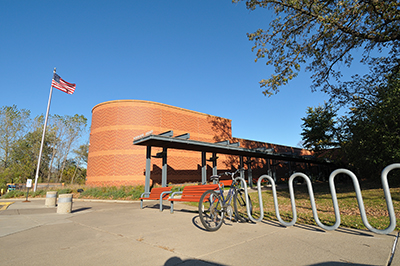Case examples
Student safety
Issue
A Twin Cities school district was concerned about the safety of students who travel underneath an I-35W bridge as they walk to and from one of the district’s middle schools. The primary problem was the lack of visibility for drivers, pedestrians, and bicyclists at the intersection of the I-35W off-ramp and the local city road. MnDOT had previously addressed this issue by trimming back brush along the I-35W off-ramp, and the city had previously improved parts of the sidewalk. The school district was looking for a more permanent solution to this safety issue.
middle schools. The primary problem was the lack of visibility for drivers, pedestrians, and bicyclists at the intersection of the I-35W off-ramp and the local city road. MnDOT had previously addressed this issue by trimming back brush along the I-35W off-ramp, and the city had previously improved parts of the sidewalk. The school district was looking for a more permanent solution to this safety issue.
Action
The Ombudsman worked with the school district, the city, and the MnDOT District to better understand underlying safety interests. The MnDOT District restriped the crosswalks before equipment needed to be winterized. The Ombudsman then convened and facilitated a meeting for all three groups to better understand each other’s safety interests and to develop long-term solutions to the issue.
Resolution
As a result of the facilitated meeting, the school district, the city, and the MnDOT District established a clear plan moving forward in which they will work together to develop further infrastructure (i.e. lighting and curb radii changes) and non-infrastructure (i.e. crossing guard) solutions to motorist, pedestrian, and bicyclist safety concerns.
Rural flooding
Issue
A constituent living near a recently constructed rural highway project was experiencing flooding problems at his home. He believed that the wetland replacement site, constructed as a part of a new highway bypass project, was responsible for the flooding.
Action
The Ombudsman’s Office met with the constituent at his property to hear directly from him and to see the extent of the moisture problem. Then the Ombudsman’s Office accompanied MnDOT personnel at the wetland replacement site as district staff compiled various measurements and notes about the area. The MnDOT District reviewed visible vegetation, elevation points, precipitation readings, and other hydrological factors. Based on the information gathered, the MnDOT District concluded that the wetland site had no impact on the moisture problems the constituent was experiencing and that above average rainy seasons were most responsible for the moisture problems. The Ombudsman’s Office shared this information with the constituent along with the district’s rationale for not taking additional action.
Resolution
The MnDOT District offered to issue a permit to the constituent to drain water from his property into the wetland site and offered to share elevation survey information so that an appropriate ditch route could be determined. The Ombudsman shared this option with the constituent as well as the formal tort claims process. The constituent appreciated the Ombudsman for sharing options, ensuring the issue was reviewed thoroughly, and for documenting the MnDOT District’s rationale for not taking additional action.
Rural student safety highway crossing
Issue
A County Commissioner contacted the MnDOT Commissioner’s Chief of Staff about the community’s concerns with pedestrian safety near their school’s campus. Highway US 75 separates the school campus from many neighborhoods in the community, therefore making it challenging for students to get to school and extra-curricular activities. The community had been working with the local MnDOT District on this issue for some time, but both had different perspectives on how to address it.
Action
The Ombudsman’s office met with representatives from both the MnDOT District and the community (including the county, city, and school district) to better understand their underlying interests. The Ombudsman’s office heard that, though the community and MnDOT had differed on how to solve the problem, everyone shared the interest of pedestrian safety. The Ombudsman’s office then facilitated a meeting in which everyone was able to share their perspectives and develop a solution together.
Resolution
As a result of the facilitated meeting, community and MnDOT representatives developed a solution for pedestrian and motorist safety that could be utilized in multiple locations at any time of the day throughout the year. The group decided to install two overhead Rectangular Rapid-Flash Beacon (RRFB) systems at locations agreeable to all. The group also developed a plan to fund these systems. The Ombudsman’s role in this matter was to informally fact-find, identify underlying interests of all involved, and facilitate communications.
Metro repetitive noise irritant
Issue
A constituent living by a bridge overpass was disturbed daily by noise caused by joint slap, the sound heard when trucks drive over the point where a road and bridge connect. The constituent had persistently complained to various government offices about the noise and felt that solutions had not been earnestly considered by MnDOT.
Action
The Ombudsman’s office met the constituent at their property to hear and experience their concerns first-hand. Then the Ombudsman’s office worked with MnDOT personnel who determined what joint slap mitigation actions had been used in similar situations and whether or not any mitigation actions could be taken in this circumstance. Mitigation actions related to each contributing factor to joint slap were reviewed by MnDOT at the location disturbing the constituent. The Ombudsman’s office recorded the bridge joint inspection conducted by district staff along with the district’s comments related to mitigation options. The Ombudsman’s office shared relevant inspection photos with the constituent along with the district’s rationale for not taking additional action beyond standard maintenance.
Resolution
Although nothing physically changed in this area, the constituent was satisfied with the result. MnDOT had been in contact with this constituent previously, but having the Ombudsman’s office involved and showing proof that the concern was taken seriously was the peace of mind that constituent needed. In situations like these, the constituent needs to feel heard and have proof that someone is genuinely listening to their concern.
